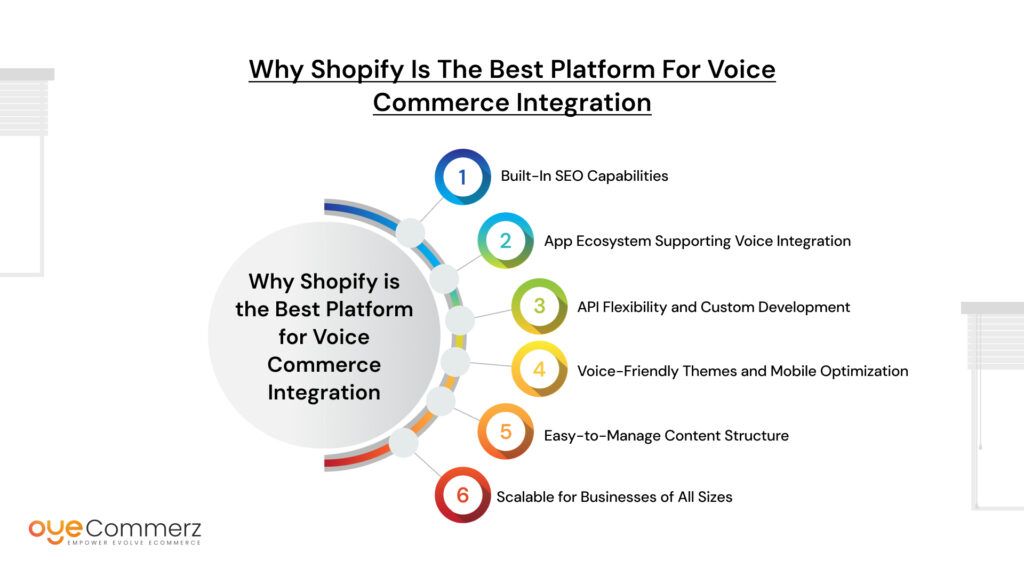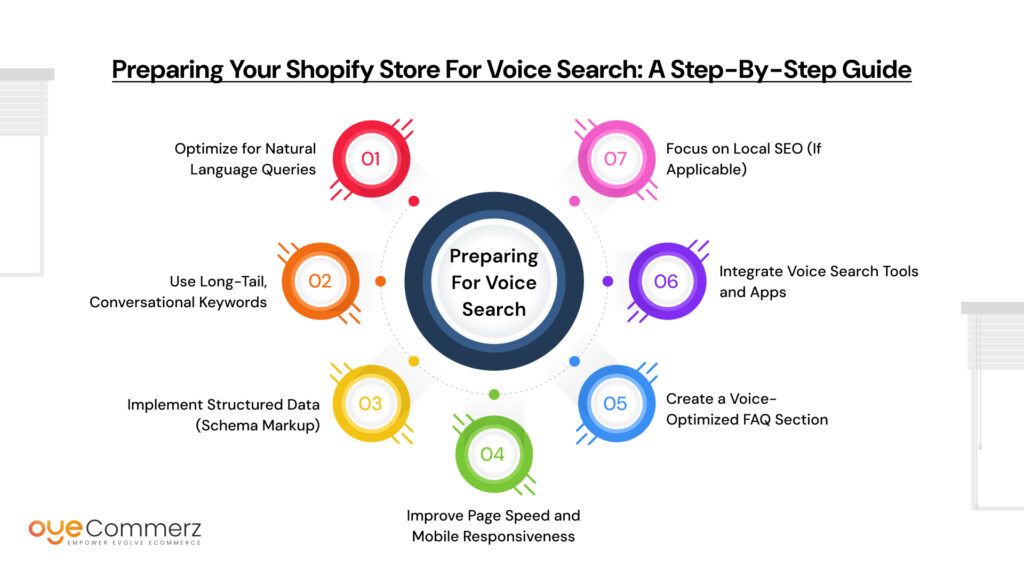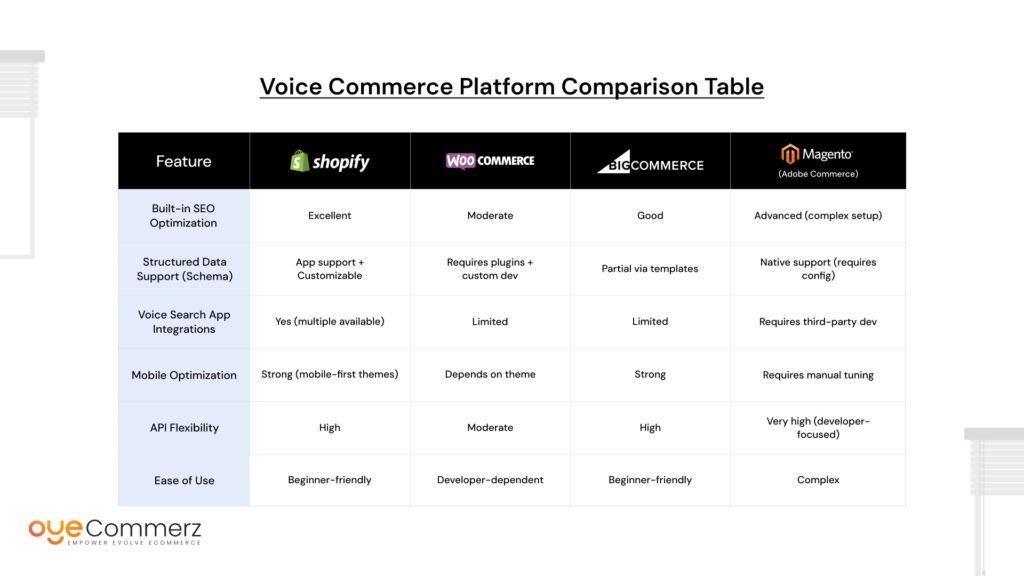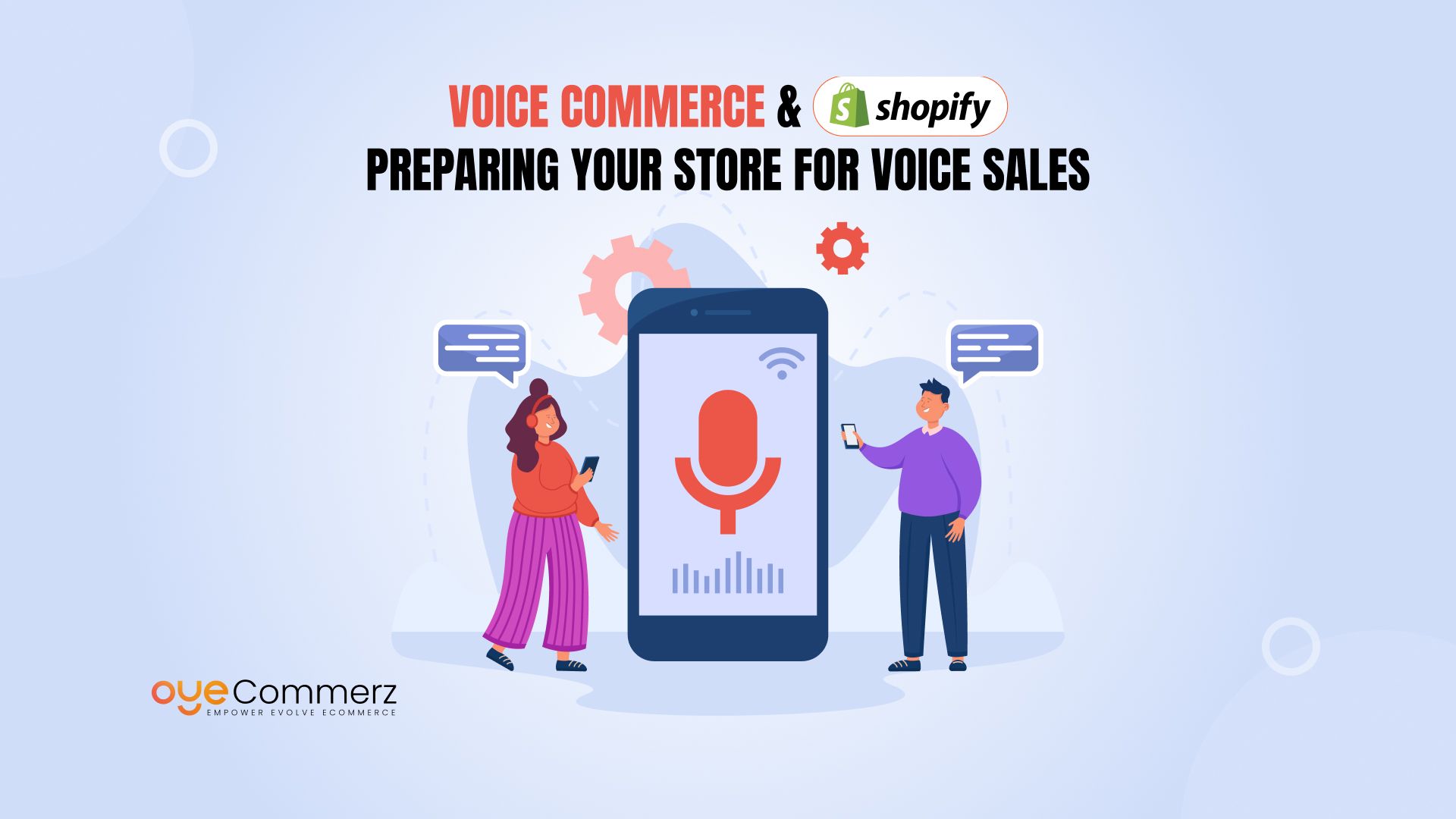Voice search isn’t just the future it’s already here. With over 50% of U.S. adults using voice assistants like Alexa, Siri, or Google Assistant on a daily basis, voice commerce is rapidly shaping how consumers discover and purchase products online.
Shopify. With its SEO-friendly structure, flexible integrations, and a strong developer ecosystem, Shopify offers one of the most voice-ready platforms in the e-commerce space. And when paired with the right strategy, your store can rank higher, convert faster, and speak your customers’ language literally.
This blog will guide you from the basics of voice commerce to the technical steps needed to optimize your Shopify store. Whether you’re just starting out or looking to upgrade, you’ll walk away with a complete roadmap for winning in the voice-first
Table of Contents
ToggleWhat is Voice Commerce? A Beginner-Friendly Explanation
Voice commerce, also known as voice-enabled shopping, is the process of buying products online using voice commands through smart devices like Amazon Alexa, Google Assistant, and Apple’s Siri. Instead of typing search queries or navigating a website manually, customers can simply speak their intent for example, “Order dog food from my favorite brand” or “What’s the best shampoo for dry hair?”
This hands-free approach to shopping is gaining momentum as voice assistants become part of daily routines in millions of American households. From searching for products to placing repeat orders, voice commerce is redefining convenience.
Here’s how it works in simple terms:
- A user activates a voice assistant on their smartphone, smart speaker, or wearable device.
- They make a spoken query or command related to a product.
- The voice assistant pulls relevant information from the web or connected shopping platforms.
- The user can hear recommendations, reviews, or prices and complete purchases using voice.
Voice commerce is especially powerful for quick, repeat, or low-consideration purchases like household items, groceries, or personal care products. And for store owners using platforms like Shopify, it opens new doors to meet customers where they are on the go, multitasking, or simply preferring voice over screen.
If you’re new to e-commerce or just starting out, voice commerce may sound futuristic, but it’s actually becoming a competitive advantage for businesses that move early. In the next section, we’ll explore how this shift is changing consumer behavior and why adapting your store now is key.
How Voice Search is Changing E-Commerce Behavior

Voice search is fundamentally altering how consumers interact with online stores. Instead of browsing through categories or typing keywords, people now speak naturally to find what they need. This shift has major implications for how products are discovered, how content is structured, and how decisions are made in the customer journey.
Here’s what’s changing:
1. From Keywords to Conversations
Traditional search relies on short, typed queries like “best budget headphones.” In contrast, voice searches are longer and more conversational—like “What are the best budget headphones for working out?” This means your product pages and content must align with natural language patterns, not just keyword density.
2. Increased Expectation for Speed and Convenience
Voice users want fast, accurate answers. They’re often multitasking—cooking dinner, driving, working out—so their attentio e-commerce strategy and span is shorter. This makes concise, structured information more valuable than ever.
3. Higher Intent and Faster Decisions
Voice searches often reflect high intent. A customer asking “Buy organic coffee near me” is much closer to conversion than someone browsing a product catalog. Voice shoppers typically know what they want—they just want it faster.
4. Emerging Use Cases by Device
- Smart speakers are commonly used for reordering or checking product status.
- Mobile voice assistants are used for quick product research or local searches.
- Wearables are starting to integrate voice search for on-the-go purchases.
New Categories of Products Gaining Ground
Initially limited to simple household items, voice commerce is now expanding into beauty, electronics, personal care, and even fashion—with curated, voice-delivered recommendations becoming more popular.
If your still revolves solely around visual browsing and keyboard inputs, it’s time to rethink. Voice commerce isn’t just a new channel it’s a new mindset. And adapting your Shopify store to match this behavior is the next step in staying ahead.
Why Shopify is the Best Platform for Voice Commerce Integration

As voice commerce continues to grow, choosing the right platform to support it becomes critical. Shopify stands out as one of the most voice-ready e-commerce platforms available offering flexibility, scalability, and a robust ecosystem to help store owners optimize for voice search and voice-activated shopping.
Here’s why Shopify is a strong foundation for voice commerce:
1. Built-In SEO Capabilities
Shopify is designed with clean code, fast load speeds, and mobile responsiveness all essential for ranking well in search results that voice assistants pull from. Optimizing your store for voice search starts with strong technical SEO, and Shopify makes that easier out of the box.
2. App Ecosystem Supporting Voice Integration
There are apps in the Shopify App Store that support voice search functionality, voice-to-text browsing, and AI-powered conversational tools. These apps allow you to turn basic storefronts into intelligent, voice-compatible shopping experiences.
3. API Flexibility and Custom Development
For more advanced needs, Shopify’s API ecosystem makes it easy to integrate with third-party voice technologies like Google Assistant or Amazon Alexa. Developers can create custom experiences tailored to your product niche, industry, or buyer persona.
4. Voice-Friendly Themes and Mobile Optimization
Most Shopify themes are mobile-first, which naturally complements voice search behaviors that happen on mobile devices and wearables. Clear navigation, fast loading times, and structured data enhance usability for voice search users.
5. Easy-to-Manage Content Structure
Voice search favors structured content FAQs, headings, product descriptions, and metadata that answer questions directly. Shopify’s content management tools make it easy to update and optimize this kind of content without needing a developer for every change.
6. Scalable for Businesses of All Sizes
Whether you’re launching your first online store or migrating a large catalog from another platform, Shopify scales with your business and adapts to new technologies like voice commerce without heavy infrastructure changes.
If you want a platform that keeps up with how consumers are shopping not just today, but tomorrow Shopify provides the tools, integrations, and flexibility to stay competitive in the age of voice.
Preparing Your Shopify Store for Voice Search: A Step-by-Step Guide

Getting your Shopify store ready for voice commerce isn’t just about adding a plugin it’s about rethinking how your content, structure, and user experience align with how people speak and search. Below is a step-by-step roadmap to help you optimize your store for voice search and voice-driven sales.
1. Optimize for Natural Language Queries
Voice search is conversational. Instead of short phrases, users speak in full questions or statements. Update your content to reflect how people talk. Include full-sentence FAQs, question-style headings, and long-tail keywords like “What are the best shoes for nurses on their feet all day?”
2. Use Long-Tail, Conversational Keywords
Focus your SEO strategy on long-tail keywords that reflect how real people talk. Tools like Google’s People Also Ask and Answer the Public can help uncover voice-style search terms. Incorporate these into product descriptions, headings, and blog content.
3. Implement Structured Data (Schema Markup)
Voice assistants pull data from structured content. Use JSON-LD schema to help Google understand your product pages, FAQs, and local business information. Shopify apps like Smart SEO or custom code can help implement this effectively.
4. Improve Page Speed and Mobile Responsiveness
Voice users expect fast results, especially on mobile. Shopify already delivers fast load times, but compressing images, limiting third-party scripts, and using a lightweight theme can make your store even faster. Test your speed with Google PageSpeed Insights.
5. Create a Voice-Optimized FAQ Section
A well-structured FAQ page can be a goldmine for voice SEO. Each question should reflect a real-world spoken query and be followed by a concise, direct answer. This increases your chances of ranking for voice-based queries and appearing in featured snippets.
6. Integrate Voice Search Tools and Apps
Shopify supports apps and third-party tools that enable voice browsing, voice search bars, and even voice product finders. Consider integrating tools like Voice Search by Expert Village Media or using custom development to enable voice-triggered navigation.
7. Focus on Local SEO (If Applicable)
Voice search is often location-specific—users say things like “find eco-friendly candles near me.” Make sure your store is listed on Google Business Profile, includes local keywords, and features location details prominently on your site.
Technical Deep Dive: Voice Search SEO for Shopify
While voice commerce may feel like a user experience enhancement on the surface, its foundation is deeply rooted in technical SEO. To fully prepare your Shopify store for voice search, you need to understand how voice assistants gather and prioritize information and how your store can align with those mechanics.
Here’s a breakdown of the core technical elements that make your Shopify store voice-ready:
1. Understanding How Voice Assistants Pull Data
Voice assistants like Google Assistant, Siri, and Alexa rely on structured data, fast-loading pages, and content that directly answers user queries. Most voice responses are pulled from featured snippets, knowledge graphs, and schema-marked pages. Your goal should be to create pages that are clear, concise, and answer questions within the first few lines.
2. Use of Structured Data with JSON-LD
Shopify themes and apps support the integration of structured data using JSON-LD. This markup helps search engines understand your products, prices, ratings, availability, and FAQs. It’s crucial for voice search, especially for triggering rich results and answering direct questions. Tools like Schema App or Smart SEO can help add and manage JSON-LD on Shopify.
3. Optimize for Featured Snippets
Most voice search results are drawn from featured snippets. To compete for these positions, write content that:
- Answers a specific question in the first sentence
- Uses bullet points or numbered lists when applicable
- Includes the target query as a header
Add voice-friendly content to product pages, blog posts, and especially your FAQ section.
4. Improve Site Performance and Core Web Vitals
Voice search results prioritize fast-loading, mobile-optimized pages. Shopify stores already perform well here, but it’s worth fine-tuning:
- Minimize unused code and apps
- Compress images with tools like TinyIMG
- Use a lightweight, voice-optimized theme
- Monitor metrics via Google Search Console and PageSpeed Insights
5. Focus on Conversational Content Structure
Structure your content to match voice assistant parsing. This includes:
- Using simple language and sentence structure
- Avoiding jargon unless necessary
- Adding context-rich subheadings and clearly labeled sections
6. Mobile and Voice Search Testing Tools
Since most voice searches are conducted on mobile devices, regularly test your site using:
- Mobile-Friendly Test by Google
- Voice search simulator tools like SEMrush Voice Search Report
- Real-world testing with different assistants (Google Assistant, Siri, Alexa)
7. Secure and HTTPS-Enabled Site
Security is a trust factor for both users and search engines. Make sure your Shopify site uses HTTPS (Shopify provides this by default), as non-secure sites are deprioritized in search and likely excluded from voice responses altogether.
The key to dominating voice search is aligning your content and technical setup with how voice assistants interpret, evaluate, and deliver answers. Shopify gives you a strong framework, but success depends on implementing the right SEO practices that speak to both users and machines.
Comparing Voice Commerce Capabilities: Shopify vs Other Platforms

If you’re evaluating platforms for voice commerce readiness, it’s important to understand how Shopify stacks up against other major e-commerce solutions. Below is a comparison of key features that matter when preparing a store for voice search and voice-enabled shopping.
Key Takeaways:
- Shopify is ideal for merchants looking for a ready-to-use, scalable platform that supports voice search out of the box through apps and integrations.
- WooCommerce offers flexibility but often requires developer involvement and custom plugins for voice search features.
- BigCommerce is competitive but currently has limited voice-specific integrations.
- Magento is powerful and customizable, but its complexity and cost make it better suited for large enterprises with dedicated technical teams.
For small to mid-sized businesses looking to move quickly into voice commerce, Shopify offers the best balance of features, cost, and ease of implementation.
Need to Migrate to Shopify for Voice Commerce? Oyecommerz Can Help
If you’re considering a move to Shopify to take full advantage of voice commerce, you’re not alone. As more businesses recognize the importance of voice-enabled shopping, many are transitioning from outdated platforms to Shopify’s scalable, voice-ready ecosystem.
But migration isn’t just about transferring products and themes. It’s about setting up your store with performance, SEO, and future growth in mind especially if voice commerce is part of your strategy.
That’s where Oyecommerz comes in.
Why Choose Oyecommerz for Your Shopify Migration?
End-to-End Migration Expertise
Whether you’re coming from WooCommerce, Magento, Squarespace, or any custom platform, Oyecommerz ensures a smooth, structured migration process with zero data loss and zero downtime.
Voice-Ready Store Setup
Oyecommerz goes beyond basic store setup. They help you structure your content, metadata, and technical SEO to align with voice search best practices so your store doesn’t just look good, it performs well in spoken queries.
Custom Development and App Integration
Need voice search functionality? Oyecommerz can integrate voice-search-ready apps or even build custom features to match your customer journey and industry needs.
Post-Migration Support and Optimization
After launch, their team continues to optimize your store with speed enhancements, structured data setup, and SEO audits—all aligned with voice-first strategies.
U.S.-Focused Market Experience
Oyecommerz understands the U.S. e-commerce market and consumer behavior, ensuring your voice commerce strategy speaks directly to your audience.
If you’re serious about future-proofing your store and maximizing voice-driven sales, migrating to Shopify with Oyecommerz is a smart move.
Start Selling Smarter with Voice Commerce on Shopify
Voice search is changing how customers shop don’t let your store fall behind. At Oyecommerz, we help brands optimize or migrate their e-commerce sites to Shopify with full voice search compatibility. Whether you’re starting from scratch or upgrading your current platform, our team ensures your store is fast, SEO-friendly, and ready for voice-driven sales.
Get in touch now for a free consultation and discover how voice commerce can unlock new growth for your Shopify store.
Contact to Migrate your Site to Shopify Now
Key Takeaways and Next Steps
Voice commerce isn’t a trend—it’s a shift in how people interact with technology and make purchasing decisions. With millions of U.S. consumers using voice assistants daily, the window to optimize your online store for voice search is now.
Here’s what we covered:
- Voice commerce is growing rapidly, with consumers favoring hands-free, fast, and conversational shopping experiences.
- Shopify is one of the best platforms to support voice search, offering flexibility, integrations, and built-in SEO advantages.
- Preparing your store means aligning content, SEO, structure, and speed with how people speak not just type.
- A technical SEO foundation, including structured data and mobile-first optimization, is essential for voice visibility.
- Compared to other platforms, Shopify provides the strongest balance of performance, ease of use, and voice-readiness.
- For brands ready to make the switch, Oyecommerz offers expert Shopify migration services built for voice commerce success.
Your Next Steps:
- Audit your current store to evaluate voice readiness look at content structure, site speed, and keyword strategy.
- Plan your migration or optimization strategy based on where you are today whether you’re starting fresh or switching platforms.
- Connect with a Shopify expert team like Oyecommerz to guide your store into the future of e-commerce.
Voice commerce is changing how people shop. With the right strategy, platform, and support, your brand can stay ahead delivering a faster, smarter, and more intuitive experience for every customer.
Ready to make your store voice-first?
Explore Shopify migration and voice optimization services at Oyecommerz.
Conclusion
The rise of voice commerce is undeniable. As more consumers turn to voice assistants for shopping, businesses must adapt to remain competitive. Shopify stands out as a powerful platform to future-proof your online store, providing the tools and flexibility to integrate voice search, optimize for conversational queries, and enhance the overall customer experience.
Whether you’re a small business just starting or an established brand looking to optimize for voice search, now is the time to act. Adapting your store to meet the demands of voice commerce ensures you’re not only staying relevant but also positioning your brand to capture a growing segment of tech-savvy, convenience-driven customers.
If you’re ready to migrate to Shopify or need expert help in optimizing your store for voice search, Oyecommerz is here to guide you through every step. Their migration services ensure a seamless transition while preparing your store for success in the voice-first era.
Voice commerce is here to stay make sure your Shopify store is ready to lead the charge.
Frequently Asked Questions
An example of voice commerce is a consumer using their Amazon Alexa or Google Assistant to place an order, like saying, “Hey Google, reorder my favorite coffee.” The device processes the command, accesses the user’s shopping history, and completes the purchase seamlessly.
To activate voice search, integrate a voice search app or plugin on your Shopify store. These apps allow users to search for products using voice commands. Additionally, optimizing your store’s SEO for natural language queries and conversational keywords is key.
The e-commerce voice process involves customers using voice assistants to search for products, get recommendations, and make purchases. It typically includes voice commands like “What’s the best laptop under $500?” followed by a purchase or addition to the shopping cart, all completed through voice.
Voice commerce offers businesses a new way to connect with customers, providing a faster, hands-free shopping experience that meets the increasing demand for convenience.
Voice search impacts SEO by shifting focus to long-tail, conversational keywords. Stores need to optimize for questions and answers, structured data, and mobile-friendly design to capture voice search traffic effectively.




